|
|
|
Sort Order |
|
|
|
Items / Page
|
|
|
|
|
|
|
| Srl | Item |
| 1 |
ID:
151753
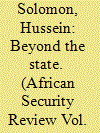

|
|
|
|
|
| Summary/Abstract |
Confronted with myriad security challenges, African states and the much-vaunted peace and security architecture of the African Union (AU) has proven not to be up to the challenge. Indeed, this is implicitly acknowledged by the AU itself if one considers the creation of such security structures as the African Mission in Somalia (AMISOM), which exists outside its peace and security architecture. This paper argues for a radical rethink of security structures on the African continent – one in which state structures of security coexist with newer forms of security actors, including private military companies (PMCs), community movements and the business sector. Whilst this shift in security actors is already happening on the ground, policymakers need to embrace this new reality.
|
|
|
|
|
|
|
|
|
|
|
|
|
|
|
|
| 2 |
ID:
131979
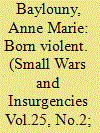

|
|
|
|
|
| Publication |
2014.
|
| Summary/Abstract |
We know little of the internal governing practices of non-state actors once in control of territory. Some territories have witnessed the establishment of new institutions of public goods remarkably similar to state institutions. This article compares four armed political parties governing territory during the Lebanese civil war. These non-state violent actors established complex political and economic institutions and administrative structures. Despite the wide range of ideologies and identities of these actors, they all converged in their institutional priorities, although not in their capacities or the particular ways of achieving those priorities. Data from interviews and the actions of the armed political parties suggest a combination of ideology and desire for control is causal in generating public institutions, partly attributable to the high degree of citizen activism marking the Lebanese case.
|
|
|
|
|
|
|
|
|
|
|
|
|
|
|
|
| 3 |
ID:
133516
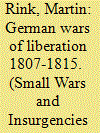

|
|
|
|
|
| Publication |
2014.
|
| Summary/Abstract |
In the Age of Napoleon, 'small wars' and 'revolutionary war' were closely connected. There were, however, different strands of this phenomenon: speaking professionally, conservative officers condemned small wars as an irregular regression to previous less disciplined forms of warfare. The Prussian state continually tried to discipline and regulate spontaneous risings. Yet the irregular character of small wars offered the opportunities for a less complex way of fighting, thus enabling the arming of the 'people' to fight. Individual undertakings, such as Ferdinand von Schill's doomed campaign in 1809, were designed to spark off a general popular uprising. But they were cheered by many and supported by few. Meanwhile, Neidhardt von Gneisenau conceived guerrilla-style Landsturm home-defence forces, which were designed for an irregular people's war. These concepts were put into practice in the 'war of freedom' - or 'war of liberation' - in 1813. Eventually both the mobilisation and the tactics remained regular, however, despite the emphatic appeal to a national 'people's war'.
|
|
|
|
|
|
|
|
|
|
|
|
|
|
|
|
| 4 |
ID:
177838


|
|
|
|
|
| Summary/Abstract |
State security forces have been locked in an ongoing struggle with the Communist Party of the Philippines – New People’s Army (NPA) for nearly fifty years. Over the course of the conflict, thousands of civilians across generations have taken up arms and participated in the counterinsurgency campaign. Citizen Armed Force Geographical Units (CAFGU) and other pro-government militias have played a key auxiliary role in combatting the insurgency and providing community security. This article draws on survey and interview data collected from CAFGU participants to examine the factors that influence decisions to join, as well as their implications for sustained participation and counterinsurgency strategy. Existing research on joining armed groups recognizes how environmental conditions, group processes, and individual motives interact to help explain participation. We shift our focus to the realm of the household and highlight how considerations related to that site affect participation. Our findings suggest that the need to avoid economic disaster and ensure a secure subsistence can have a notable influence on decisions to enlist and individual experiences as CAFGU. These effects, in turn, have implications for how the Philippine government carries out its counterinsurgency.
|
|
|
|
|
|
|
|
|
|
|
|
|
|
|
|
| 5 |
ID:
154235
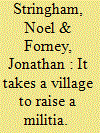

|
|
|
|
|
| Summary/Abstract |
Why does South Sudan continue to experience endemic, low intensity conflicts punctuated by catastrophic civil wars? Reporters and analysts often mischaracterise conflicts in the young country of South Sudan as products of divisive ‘tribal’ or ‘ethnic’ rivalries and political competition over oil wealth. More nuanced analyses by regional experts have focused almost exclusively on infighting among elite politicians and military officers based in Juba and other major cities who use patronage networks to ethnicise conflicts. This paper argues instead that civilian militias known as the Nuer White Army have consistently rebelled against elites who they blame for mounting inequalities between urban areas and the rural communities regardless of their ethnicity. While unable to stop governments and NGOs from funnelling almost all their resources to the cities, these militias have consistently mobilised local resources for violent campaigns that redistribute wealth by pillaging urban areas.
|
|
|
|
|
|
|
|
|
|
|
|
|
|
|
|
| 6 |
ID:
178688
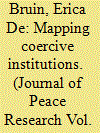

|
|
|
|
|
| Summary/Abstract |
How rulers organize and use their security forces is thought to have important implications for regime survival, repression, and military effectiveness. While a number of studies provide insight into the coercive institutions of individual states, efforts to understand systematic patterns have been hampered by a lack of reliable data on state security forces that can be compared across states and within them over time. This article presents the State Security Forces (SSF) dataset, which includes 375 security forces in 110 countries, 1960–2010. It tracks how each force is commanded, staffed, equipped, and deployed, as well as the number of security forces and potential counterweights in each state’s security sector as a whole. After illustrating how the SSF dataset differs from related ones and presenting descriptive trends, the article shows how it can be used to deepen our understanding of coup-proofing and strategic substitution, and identifies additional research uses of the dataset.
|
|
|
|
|
|
|
|
|
|
|
|
|
|
|
|
| 7 |
ID:
160878
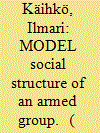

|
|
|
|
|
| Summary/Abstract |
This article investigates the Movement for Democracy in Liberia (MODEL) through a revised Weberian framework that focuses on legitimacy and offers a thick description of the different phases of this armed group. The article argues that the key to fostering cohesion is the harmonization of the micro, meso, and macro levels. This proved a difficult undertaking for the MODEL. Not only did the MODEL lack material resources but it also relied on different and evolving kinds of legitimacy on these levels. With its sources of legitimacy exhausted after the war, the MODEL ceased to exist.
|
|
|
|
|
|
|
|
|
|
|
|
|
|
|
|
| 8 |
ID:
158823
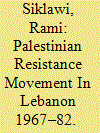

|
|
|
| 9 |
ID:
133517
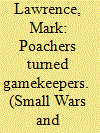

|
|
|
|
|
| Publication |
2014.
|
| Summary/Abstract |
This article modifies the associations made by historians and political scientists of Spanish guerrilla warfare with revolutionary insurgency. First, it explains how the guerrilla phenomenon moved from a Leftist to a reactionary symbol. Second, it compares the insurgency and counter-insurgency features of the Carlist War (1833-1840) with those of the better-known Peninsular War (1808-1814). Third, it shows how erstwhile guerrilla leaders during the Carlist War made their expertise available to the counter-insurgency, in a socio-economic as well as military setting. This article revises the social banditry paradigm in nineteenth-century Spain in the under-researched context of Europe bloodiest nineteenth-century civil war.
|
|
|
|
|
|
|
|
|
|
|
|
|
|
|
|
| 10 |
ID:
078972
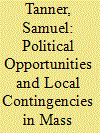

|
|
|
|
|
| Publication |
2007.
|
| Summary/Abstract |
Participation in mass crime is often approached from a top-down perspective that centralizes the actions of the masses under the order of elites and leaders. While there is some evidence to support this approach, a more complete assessment of participation in mass crime must also consider the grassroots contingencies that unite the collective motivation and capacity that induce such actions. Such a bottoms-up approach is developed in this article with a particular focus on the personal experiences of former Serbian militiamen who took part in scenes of mass violence in Croatia and Bosnia-Herzegovina. Interviews with former militiamen illustrate how political opportunities, diverging nationalistic attitudes, proximity to growing violence in increasingly localized killing fields, incentives to participate in parallel criminal activities, and an influence within community networks that were submerged in mass crimes united to legitimize and facilitate their personal commitment to the events that took place in this region during the 1990s
|
|
|
|
|
|
|
|
|
|
|
|
|
|
|
|
|
|
|
|
|